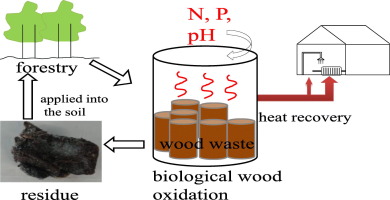当前位置:
X-MOL 学术
›
Sci. Total Environ.
›
论文详情
Our official English website, www.x-mol.net, welcomes your feedback! (Note: you will need to create a separate account there.)
Effect of nitrogen, phosphorus and pH on biological wood oxidation at 42 °C.
Science of the Total Environment ( IF 9.8 ) Pub Date : 2020-04-08 , DOI: 10.1016/j.scitotenv.2020.138569 Shiyang Fan 1 , Yue Sun 1 , Annemiek Ter Heijne 1 , Wei-Shan Chen 1 , Cees J N Buisman 2
Science of the Total Environment ( IF 9.8 ) Pub Date : 2020-04-08 , DOI: 10.1016/j.scitotenv.2020.138569 Shiyang Fan 1 , Yue Sun 1 , Annemiek Ter Heijne 1 , Wei-Shan Chen 1 , Cees J N Buisman 2
Affiliation

|
Biological wood oxidation (BWO) is proposed as a cleaner alternative to wood combustion for heat production and wood waste management. Currently, BWO is not extensively studied and little is known about it. Nevertheless, given the composition of wood residues, which is dominated by carbon, nutrient availability may become a limiting factor during BWO. Our objective was to study the nutrition requirements for sustaining the BWO. For this purpose, three different factors including nitrogen addition, phosphorus addition and pH, were studied. Oxygen consumption and mass loss were monitored and used to evaluate the impact of nutrition on BWO and to calculate the theoretical heat production. The result showed that nitrogen addition at a relatively low level (2.5-10 mg/g) enhanced the cumulative oxygen consumption by 60-124% and mass loss by 28-95%, when compared with the BWO without nitrogen addition. The highest nitrogen addition examined in this research (20 mg/g), on the other hand, did not enhance BWO. Different phosphorus addition (0.5-5 mg/g) and pH (4-6) had little impacts on BWO. The highest theoretical heat production rate (0.63 W/kg dry wood biomass) was achieved using 2.5 mg/g nitrogen addition with a 95-day incubation. This suggests that nitrogen addition is required and able to sustain BWO. Besides, the cumulative oxygen consumption showed a good linear relationship with mass loss. This study provides the first indication on the effective quantify of nitrogen addition for enhancing BWO, which contributes to the selection of nutrient source for BWO in future studies.
中文翻译:

氮,磷和pH值对42°C下生物木材氧化的影响。
提出了生物木材氧化(BWO)作为木材燃烧的更清洁替代品,以进行热量产生和木材废物管理。目前,对BWO的研究还不够广泛,对其了解甚少。然而,考虑到以碳为主导的木材残留物的组成,养分利用率在BWO期间可能成为限制因素。我们的目标是研究维持BWO所需的营养。为此,研究了三个不同的因素,包括氮添加,磷添加和pH。监测氧气消耗和质量损失,并将其用于评估营养对BWO的影响并计算理论产热量。结果表明,在相对较低的水平(2.5-10 mg / g)下添加氮可使累积耗氧量增加60-124%,质量损失增加28-95%,与不加氮的BWO相比。另一方面,这项研究中检测到的最高氮添加量(20 mg / g)并未提高BWO。添加不同的磷(0.5-5 mg / g)和pH(4-6)对BWO的影响很小。在95天的温育条件下,使用2.5 mg / g氮添加可达到最高理论产热率(0.63 W / kg干燥木材生物质)。这表明需要添加氮并且能够维持BWO。此外,累积耗氧量与质量损失呈良好的线性关系。这项研究为有效定量地增加BWO的氮添加量提供了第一个指示,这有助于在未来的研究中选择BWO的营养来源。另一方面,没有增强BWO。添加不同的磷(0.5-5 mg / g)和pH(4-6)对BWO的影响很小。在95天的温育条件下,使用2.5 mg / g氮添加可达到最高理论产热率(0.63 W / kg干燥木材生物质)。这表明需要添加氮并且能够维持BWO。此外,累积耗氧量与质量损失呈良好的线性关系。这项研究为有效定量地增加BWO的氮添加量提供了第一个指示,这有助于在未来的研究中选择BWO的营养来源。另一方面,没有增强BWO。添加不同的磷(0.5-5 mg / g)和pH(4-6)对BWO的影响很小。在95天的温育条件下,使用2.5 mg / g氮添加可达到最高理论产热率(0.63 W / kg干燥木材生物质)。这表明需要添加氮并且能够维持BWO。此外,累积耗氧量与质量损失呈良好的线性关系。这项研究为有效定量地增加BWO的氮添加量提供了第一个指示,这有助于在未来的研究中选择BWO的营养来源。在95天的温育下添加5 mg / g氮。这表明需要添加氮并且能够维持BWO。此外,累积耗氧量与质量损失呈良好的线性关系。这项研究为有效定量地增加BWO的氮添加量提供了第一个指示,这有助于在未来的研究中选择BWO的营养来源。在95天的温育下添加5 mg / g氮。这表明需要添加氮并且能够维持BWO。此外,累积耗氧量与质量损失呈良好的线性关系。这项研究为有效定量地增加BWO的氮添加量提供了第一个指示,这有助于在未来的研究中选择BWO的营养来源。
更新日期:2020-04-08
中文翻译:

氮,磷和pH值对42°C下生物木材氧化的影响。
提出了生物木材氧化(BWO)作为木材燃烧的更清洁替代品,以进行热量产生和木材废物管理。目前,对BWO的研究还不够广泛,对其了解甚少。然而,考虑到以碳为主导的木材残留物的组成,养分利用率在BWO期间可能成为限制因素。我们的目标是研究维持BWO所需的营养。为此,研究了三个不同的因素,包括氮添加,磷添加和pH。监测氧气消耗和质量损失,并将其用于评估营养对BWO的影响并计算理论产热量。结果表明,在相对较低的水平(2.5-10 mg / g)下添加氮可使累积耗氧量增加60-124%,质量损失增加28-95%,与不加氮的BWO相比。另一方面,这项研究中检测到的最高氮添加量(20 mg / g)并未提高BWO。添加不同的磷(0.5-5 mg / g)和pH(4-6)对BWO的影响很小。在95天的温育条件下,使用2.5 mg / g氮添加可达到最高理论产热率(0.63 W / kg干燥木材生物质)。这表明需要添加氮并且能够维持BWO。此外,累积耗氧量与质量损失呈良好的线性关系。这项研究为有效定量地增加BWO的氮添加量提供了第一个指示,这有助于在未来的研究中选择BWO的营养来源。另一方面,没有增强BWO。添加不同的磷(0.5-5 mg / g)和pH(4-6)对BWO的影响很小。在95天的温育条件下,使用2.5 mg / g氮添加可达到最高理论产热率(0.63 W / kg干燥木材生物质)。这表明需要添加氮并且能够维持BWO。此外,累积耗氧量与质量损失呈良好的线性关系。这项研究为有效定量地增加BWO的氮添加量提供了第一个指示,这有助于在未来的研究中选择BWO的营养来源。另一方面,没有增强BWO。添加不同的磷(0.5-5 mg / g)和pH(4-6)对BWO的影响很小。在95天的温育条件下,使用2.5 mg / g氮添加可达到最高理论产热率(0.63 W / kg干燥木材生物质)。这表明需要添加氮并且能够维持BWO。此外,累积耗氧量与质量损失呈良好的线性关系。这项研究为有效定量地增加BWO的氮添加量提供了第一个指示,这有助于在未来的研究中选择BWO的营养来源。在95天的温育下添加5 mg / g氮。这表明需要添加氮并且能够维持BWO。此外,累积耗氧量与质量损失呈良好的线性关系。这项研究为有效定量地增加BWO的氮添加量提供了第一个指示,这有助于在未来的研究中选择BWO的营养来源。在95天的温育下添加5 mg / g氮。这表明需要添加氮并且能够维持BWO。此外,累积耗氧量与质量损失呈良好的线性关系。这项研究为有效定量地增加BWO的氮添加量提供了第一个指示,这有助于在未来的研究中选择BWO的营养来源。


























 京公网安备 11010802027423号
京公网安备 11010802027423号